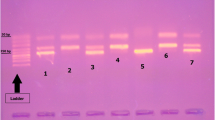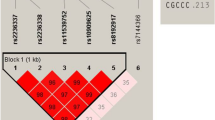Abstract
Autoimmunity is an important hypothesis in the etiology of vitiligo. Single-nucleotide polymorphisms (SNP) in protein tyrosine phosphatase nonreceptor 22 gene (PTPN22) have been linked with the development of several autoimmune diseases. In this study, we investigated the association between 1858C/T variant of the PTPN22 gene with non-segmental vitiligo in Egyptian females. One hundred female Egyptian patients suffering from non-segmental vitiligo and 120 age- and sex-matched normal Egyptian subjects were included in this study. The PTPN22 1858C/T genotypes were determined by a restriction fragment length polymorphism-polymerase chain reaction genotyping method. A nonsignificant difference in SNP in PTPN22 was found between patients and controls. The allelic frequency of 1858T (620 W) was 5 % in our patients as opposed to 12 % in controls (p = 0.17). No PTPN22 1858 TT homozygotes were observed among patients or controls. The results of this study showed no association between SNP in PTPN22 in Egyptian females with non-segmental vitiligo compared to control population. Future large scale studies are needed to confirm these results.

Similar content being viewed by others
References
Alkhateeb A, Fain PR, Thody A, Bennett DC, Spritz RA (2003) Epidemiology of vitiligo and associated autoimmune diseases in Caucasian probands and their families. Pigment Cell Res 16(3):208–214
Alkhateeb A, Qarqaz F, Al-Sabah J (2010) Al Rashaideh T. Clinical characteristics and PTPN22 1858C/T variant analysis in Jordanian Arab vitiligo patients. Mol Diagn Ther 14(3):179–184, Jun 1
Betz RC, Konig K, Flaquer A, Redler S, Eigelshoven S, Kortüm AK, Hanneken S, Hillmer A, Tuting T, Lambert J, De Weert J, Kruse R, Lutz G, Blaumeiser B, Nöthen MM (2008) The R620W polymorphism in PTPN22 confers general susceptibility for the development of alopecia areata. Br J Dermatol 158(2):389–391
Bottini N, Vang T, Cucca F, Mustelin T (2006) Role of PTPN22 in type 1 diabetes and other autoimmune diseases. Semin Immunol 18(4):207–213
Canton I, Askar S, Gavalas NG, Gawkrodger DJ, Blomoff A, Watson PF et al (2005) A single-nucleotide polymorphism in the gene encoding lymphoid protein tyrosine phosphatase (PTPN22) confers susceptibility to generalised vitiligo. Genes Immun 6:584–587
Criswell LA, Pfeiffer KA, Lum RF, Gonzales B, Novitzke J, Kern M et al (2005) Analysis of families in the multiple autoimmune disease genetics consortium (MADGC) collection: the PTPN22 620 W allele associates with multiple autoimmune phenotypes. Am J Hum Genet 76:561–571
Fernandez-Blanco L, Perez-Pampin E, Gomez-Reino JJ, Gonzalez A (2004) A CTLA-4 polymorphism associated with susceptibility to systemic lupus erythematosus. Arthritis Rheum 50:328–329
Festen EA, Goyette P, Green T, Boucher G, Beauchamp C, Trynka G, Dubois PC, Lagacé C, Stokkers PC, Hommes DW, Barisani D, Palmieri O, Annese V, van Heel DA, Weersma RK, Daly MJ, Wijmenga C, Rioux JD (2011) A meta-analysis of genome-wide association scans identifies IL18RAP, PTPN2, TAGAP, and PUS10 as shared risk loci for Crohn's disease and celiac disease. PLoS Genet 7(1):e1001283, Jan 27
Gregersen PK, Lee HS, Batliwalla F, Begovich AB (2006) PTPN22: setting thresholds for autoimmunity. Semin Immunol 18(4):214–223
Hann SK (2000) Clinical features of segmental vitligo. In: Hann SK, Nordlund JJ (eds) Vitiligo, 1st edn. Blackwell Science Ltd, Oxford, pp 49–60
Huggins RH, Schwartz RA, Janniger CK (2005) Acta Dermatovenerol Alp Panonica Adriat 137–42:144–145
Kawasaki E, Awata T, Ikegami H, Kobayashi T, Maruyama T, Nakanishi K, Shimada A, Uga M, Kurihara S, Kawabata Y, Tanaka S, Kanazawa Y, Lee I, Eguchi K (2006) Systematic search for single nucleotide polymorphisms in a lymphoid tyrosine phosphatase gene (PTPN22): association between a promoter polymorphism and type 1 diabetes in Asian populations. Am J Med Genet A 140(6):586–593, Mar 15
Kemp EH, McDonagh AJ, Wengraf DA, Messenger AG, Gawkrodger DJ, Cork MJ, Tazi-Ahnini R (2006) The non-synonymous C1858T substitution in the PTPN22 gene is associated with susceptibility to the severe forms of alopecia areata. Hum Immunol 67(7):535–539
Laberge GS, Birlea SA, Fain PR, Spritz RA (2008a) The PTPN22-1858C/T (R620W) functional polymorphism is associated with generalized vitiligo in the Romanian population. Pigment Cell Melanoma Res 21(2):206–208
Laberge GS, Bennett DC, Fain PR, Spritz RA (2008b) PTPN22 is genetically associated with risk of generalized vitiligo, but CTLA4 is not. J Invest Dermatol 128(7):1757–1762
Laddha NC, Dwivedi M, Shajil EM, Prajapati H, Marfatia YS, Begum R (2008) Association of PTPN22 1858C/T polymorphism with vitiligo susceptibility in Gujarat population. J Dermatol Sci 49:260–262
Lavrikova EIu, Nikitin AG, Seregin IuA, Zil'berman LI, Tsitlidze NM, Kuraeva TL, Peterkova VA, Dedov II, Nosikov VV (2009) Association of the C1858T polymorphism of the PTPN22 gene with type 1 diabetes. Mol Biol (Mosk) 43(6):1040–1043, Nov-Dec
Mustelin T, Rahmouni S, Bottini N, Alonso A (2003) Role of protein tyrosine phosphatases in T cell activation. Immunol Rev 191:139–147
Rezaei N, Gavalas NG, Weetman AP, Kemp EH (2007) Autoimmunity as an aetiological factor in vitiligo. J Eur Acad Dermatol Venereol 21(7):865–876
Serrano NC, Millan P, Paez MC (2006) Non-HLA associations with autoimmune diseases. Autoimmun Rev 5:209–214
Spritz RA (2007) The genetics of generalized vitiligo and associated autoimmune disease. Pigment Cell Res 20:271–278
Wiede F, Shields BJ, Chew SH, Kyparissoudis K, van Vliet C, Galic S, Tremblay ML, Russell SM, Godfrey DI, Tiganis T (2011) T cell protein tyrosine phosphatase attenuates T cell signaling to maintain tolerance in mice. J Clin Invest 121(12):4758–4774, Dec 1
Zhang XJ, Chen JJ, Liu JB (2005) The genetic concept of vitiligo. J Dermatol Sci 39(3):137–146
Zhebrun D, Kudryashova Y, Babenko A, Maslyansky A, Kunitskaya N, Popcova D, Klushina A, Grineva E, Kostareva A, Shlyakhto E (2011) Association of PTPN22 1858T/T genotype with type 1 diabetes, Graves' disease but not with rheumatoid arthritis in Russian population. Aging (Albany NY) 3(4):368–373
Author information
Authors and Affiliations
Corresponding author
Rights and permissions
About this article
Cite this article
Elmongy, N.N., Abu Khalil, R.E. PTPN22 gene polymorphism in Egyptian females with non-segmental vitiligo. Comp Clin Pathol 22, 961–964 (2013). https://doi.org/10.1007/s00580-012-1508-4
Received:
Accepted:
Published:
Issue Date:
DOI: https://doi.org/10.1007/s00580-012-1508-4




